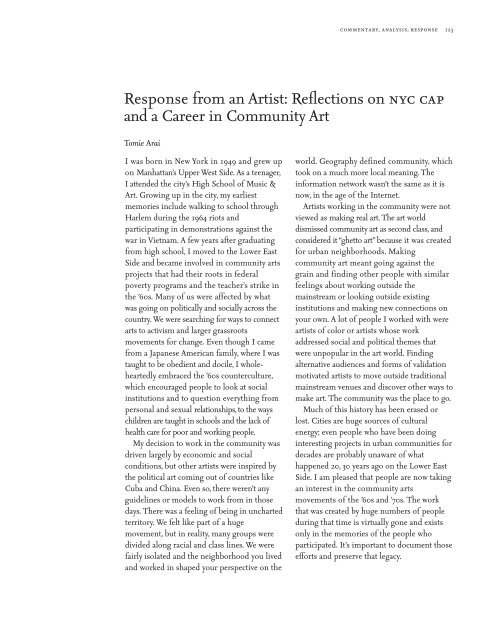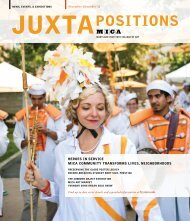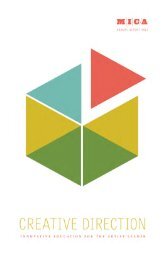art/vision/voice - Maryland Institute College of Art
art/vision/voice - Maryland Institute College of Art
art/vision/voice - Maryland Institute College of Art
You also want an ePaper? Increase the reach of your titles
YUMPU automatically turns print PDFs into web optimized ePapers that Google loves.
I was born in New York in 1949 and grew up<br />
on Manhattan’s Upper West Side. As a teenager,<br />
I attended the city’s High School <strong>of</strong> Music &<br />
<strong>Art</strong>. Growing up in the city, my earliest<br />
memories include walking to school through<br />
Harlem during the 1964 riots and<br />
p<strong>art</strong>icipating in demonstrations against the<br />
war in Vietnam. A few years after graduating<br />
from high school, I moved to the Lower East<br />
Side and became involved in community <strong>art</strong>s<br />
projects that had their roots in federal<br />
poverty programs and the teacher’s strike in<br />
the ’60s. Many <strong>of</strong> us were affected by what<br />
was going on politically and socially across the<br />
country. We were searching for ways to connect<br />
<strong>art</strong>s to activism and larger grassroots<br />
movements for change. Even though I came<br />
from a Japanese American family, where I was<br />
taught to be obedient and docile, I wholehe<strong>art</strong>edly<br />
embraced the ’60s counterculture,<br />
which encouraged people to look at social<br />
institutions and to question everything from<br />
personal and sexual relationships, to the ways<br />
children are taught in schools and the lack <strong>of</strong><br />
health care for poor and working people.<br />
My decision to work in the community was<br />
driven largely by economic and social<br />
conditions, but other <strong>art</strong>ists were inspired by<br />
the political <strong>art</strong> coming out <strong>of</strong> countries like<br />
Cuba and China. Even so, there weren’t any<br />
guidelines or models to work from in those<br />
days. There was a feeling <strong>of</strong> being in unch<strong>art</strong>ed<br />
territory. We felt like p<strong>art</strong> <strong>of</strong> a huge<br />
movement, but in reality, many groups were<br />
divided along racial and class lines. We were<br />
fairly isolated and the neighborhood you lived<br />
and worked in shaped your perspective on the<br />
commentary, analysis, response 123<br />
Response from an <strong>Art</strong>ist: Reflections on nyc cap<br />
and a Career in Community <strong>Art</strong><br />
Tomie Arai<br />
world. Geography defined community, which<br />
took on a much more local meaning. The<br />
information network wasn’t the same as it is<br />
now, in the age <strong>of</strong> the Internet.<br />
<strong>Art</strong>ists working in the community were not<br />
viewed as making real <strong>art</strong>. The <strong>art</strong> world<br />
dismissed community <strong>art</strong> as second class, and<br />
considered it “ghetto <strong>art</strong>” because it was created<br />
for urban neighborhoods. Making<br />
community <strong>art</strong> meant going against the<br />
grain and finding other people with similar<br />
feelings about working outside the<br />
mainstream or looking outside existing<br />
institutions and making new connections on<br />
your own. A lot <strong>of</strong> people I worked with were<br />
<strong>art</strong>ists <strong>of</strong> color or <strong>art</strong>ists whose work<br />
addressed social and political themes that<br />
were unpopular in the <strong>art</strong> world. Finding<br />
alternative audiences and forms <strong>of</strong> validation<br />
motivated <strong>art</strong>ists to move outside traditional<br />
mainstream venues and discover other ways to<br />
make <strong>art</strong>. The community was the place to go.<br />
Much <strong>of</strong> this history has been erased or<br />
lost. Cities are huge sources <strong>of</strong> cultural<br />
energy; even people who have been doing<br />
interesting projects in urban communities for<br />
decades are probably unaware <strong>of</strong> what<br />
happened 20, 30 years ago on the Lower East<br />
Side. I am pleased that people are now taking<br />
an interest in the community <strong>art</strong>s<br />
movements <strong>of</strong> the ’60s and ’70s. The work<br />
that was created by huge numbers <strong>of</strong> people<br />
during that time is virtually gone and exists<br />
only in the memories <strong>of</strong> the people who<br />
p<strong>art</strong>icipated. It’s important to document those<br />
efforts and preserve that legacy.
















